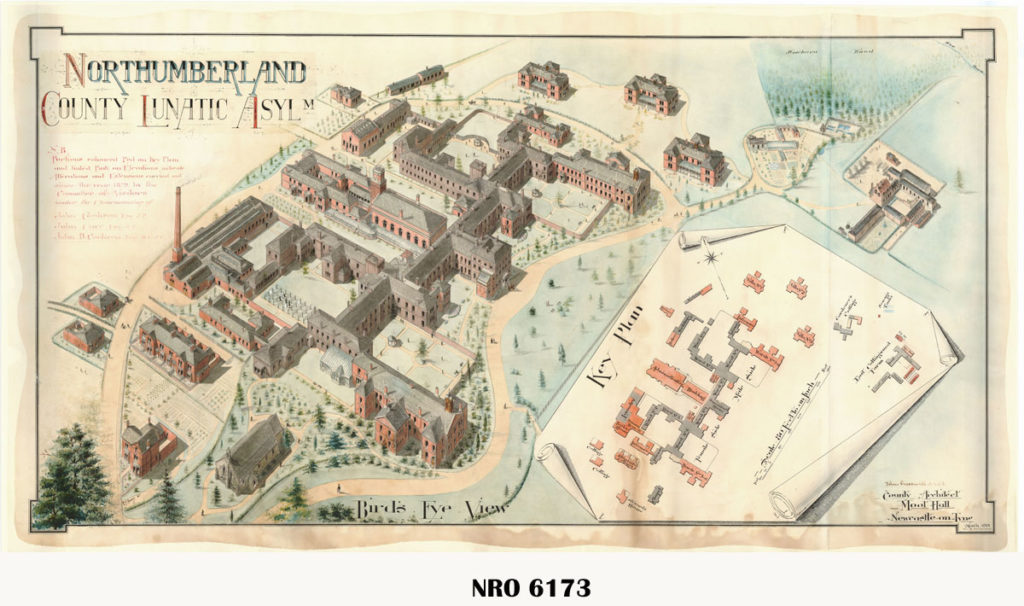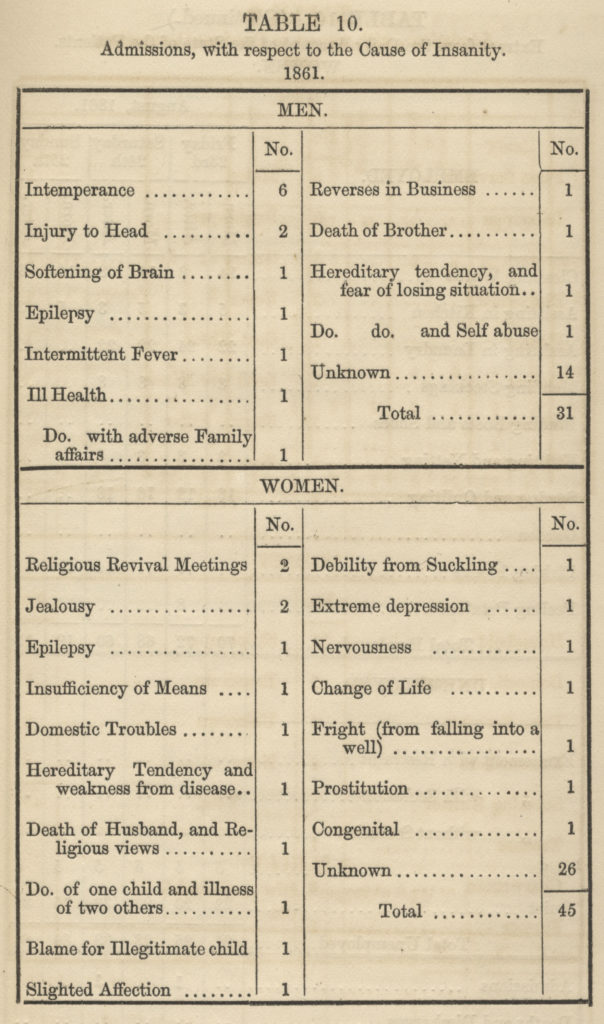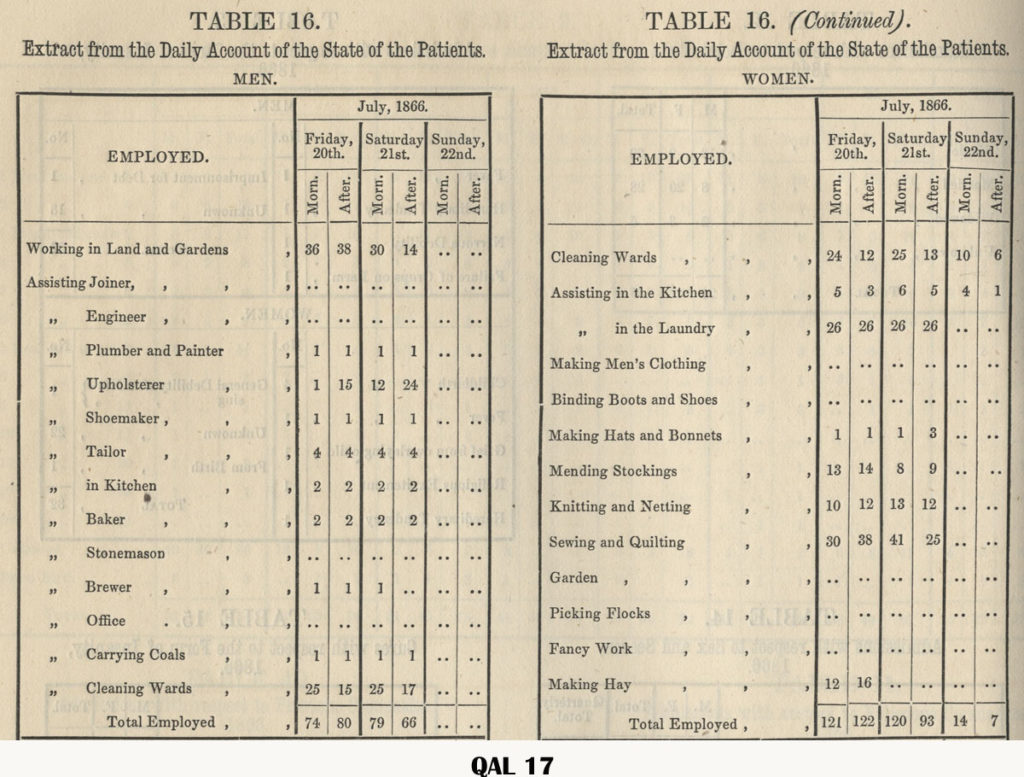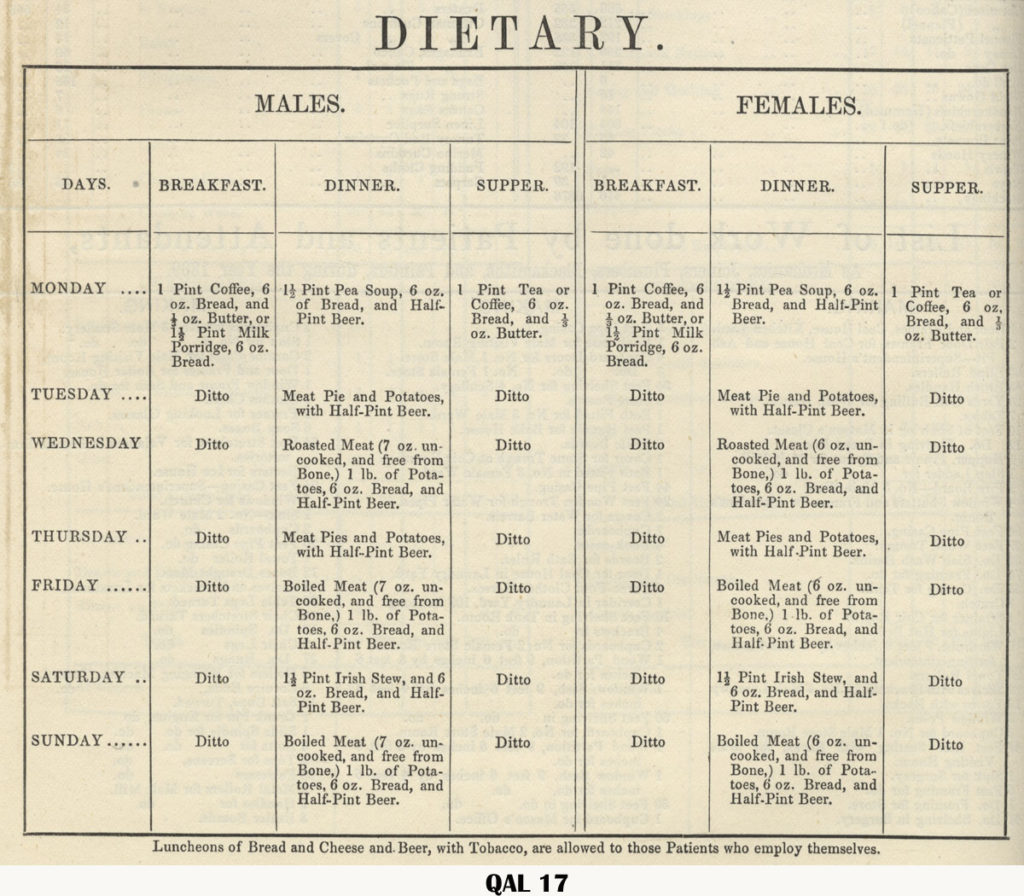
The Northumberland County Pauper Lunatic Asylum opened on 16 March 1859. Lunatic Asylums were managed by Committees of Visitors appointed by the Quarter Sessions under the Lunacy Act 1845 and were subject to visits by the Commissioners in Lunacy. Situated in Cottingwood, Morpeth, the asylum was a magnificent Victorian building built in the Italian style of red brick with stone dressings. Designed by Henry Welsh, it was originally built to accommodate about 200 male and female patients. In 1890 the asylum was renamed the County Mental Hospital then in 1937, the name was changed to St. George’s Hospital. In 2006, St. Georges Park, a purpose built mental health hospital was built on the old St. George’s site.
In 1901, the architect John Cresswell created a birds eye view plan which gave a 3 dimensional view of the asylum and its grounds. The apartments on the west side were for female inmates while males were situated on the east. Surrounding the buildings were pleasure and kitchen gardens as well as a stone chapel and brewery. The Superintendent was the principal officer of the asylum and was required to be a medical practitioner and legally qualified. The Matron was responsible for all female attendants, servants and female patients and the Clerk/Steward for male patients and male staff.

Early records for the asylum show it to be professionally managed. All male and female patients had to be kept in separate wards. No male attendant, servant or patient could enter the female wards, nor any female enter the male wards except in cases where the Superintendent deemed it advisable. The Asylum Rule Book stated the following:
“There be at least one attendant for every ward and that there be not less than one attendant for every 25 patients who are tranquil or convalescent and not less than one attendant for every 12 patients who are dirty, violent, refractory or dangerous to themselves or others. No ward shall be left at any time without an attendant being there and that the attendant be so distributed that in case of need they may readily assist each other.”

A booklet entitled Rules of Government for the Pauper Lunatic Asylum 1860 stated that dormitories had to contain no more than 3 beds and had to have a space of at least 2 feet and six inches between them. An attendant had to sleep in an adjoining room and a light was kept on through the night. No patient was to be struck or kept in perpetual restraint or seclusion. If a patient needed to be restrained, it had to be reported to the Superintendent as soon as possible and documented in the Day Book. Visitors were permitted to the asylum once a fortnight. Every visit made by a male relation or friend to a female patient had to have the Matron or female attendant present throughout the entire visit. The booklet also stated that in relation to the death of a patient, the passing had to be firstly reported to the parish officer. The House Steward would then inform one of the nearest relations of the deceased and the body would be delivered to them if requested. If the body was not taken by the fourth day, it was buried under the direction of the Superintendent.
During the day patients of both sexes were employed. Men worked in the garden and were taught trades by Shoemakers, Tailors, Plumbers and Painters. The women worked in the laundry and kitchen and also undertook sewing, knitting and mending work. Reading was encouraged and an ample supply of books and publications of a moral and cheerful nature had to be made available. This was in addition to the bible and prayer books.

The Superintendent issued a yearly report commenting on admissions, discharges and deaths. Recommendations were made for improvements to the building and patient care but events and observations were also recorded. The report for 1868 stated that when one woman was admitted she was searched and was found to have on her person money and bankers receipts of upwards of £500. The sum was unknown to her husband or family and was shrouded in mystery. It was noted that every Wednesday evening there was a dance interspersed with songs and on two occasions a conjuring entertainment was kindly provided by Mr Shute, the Assistant Surgeon. In the summer months the men played cricket, bowls, quoits and football while the women played croquet. The patients also enjoyed picnics at the seaside.
The Commissioners in Lunacy also visited the asylum and issued a yearly report. The report for 1867 claimed that the state of the inmates was satisfactory, their person and clothing were very clean and in general their conduct was orderly with nobody in seclusion. On the day of the visit dinner consisted of baked meat, potatoes, bread and beer. The wards were clean and properly ventilated but were said to have a bare appearance. It was noted that a good deal of painting, colouring and papering was required and it was hoped that the most cheerful, light and pleasing colours would be chosen. Space was a major concern and the day rooms were classed as being seriously overcrowded. The report for 1873 commented upon the death of a male patient who had died due to a blow to the head but who was also found to have his breast bone and five ribs fractured. It was never discovered how these injuries were inflicted. A female patient was also mentioned as when out walking with a party of other females she committed suicide by jumping in the river. Due to this incident walks outside of the asylum had been terminated.


The sister of my 2xgreat-grandmother was admitted to St Georges on 1 Aug 1859 from Durham County Asylum and died there 4 Sept 1877. Her husband was left to bring up their children, ages ranging from 7 to 17 in 1859. Her youngest child was born about 1858 at Sedgefield, Co Durham (presumably in the Asylum there) and was with her in St George’s on the 1861 Census, aged 2. By 1871 he was living with his father and siblings in North Northumberland. How long did children remain with their mother at St Georges? Were there separate facilities and accommodation for mothers with babies? Her mental disorder was mania but wonder what it would be today? She was aged about 42 when her youngest child was born in Sedgefield. Wonder if it was associated with her pregnancy. Seems a shame she was a patient for almost 20 years with something which would probably be treatable at home today.
Thank you for your enquiry.
In order to answer your questions fully we would need to look at the records in more detail and this would be classed as research for which there is a charge of £30 per hour. Could you please email us at collections@woodhorn.org.uk if you would like to proceed.
Thank you.
Very interested in the archive that is available for this institution, I have worked previously on the History of Mental intuitions in nineteenth-century Scotland, the role of religion and Royal Edinburgh Asylum and mortality in general.
My other research has included death and burial customs/vital registration and Welfare in eighteenth and nineteenth century Newcastle.
Could I ask what documents have survived for this institution and the longevity of the sources?
Best wishes,
Graham Butler, Ph.D.
Thank you for your enquiry.
The main collection of St George’s records in our collection is NRO 3680 and a list of exactly what we hold can be found on our electronic catalogue by entering NRO 03680* in the reference field. This collection contains items including patient case books and registers of patients and the dates range from 1859-1988. We also have material relating to the asylum in our Quarter Session records and these include correspondence relating to the building of the asylum, plans, accounts, staffing roles and rules and regulations. The dates range from 1844-c.1902.
hi there on 26th December 1873 a lady named Hannah sweet was admitted into this hospital she my x6great grandmother and I’m trying to find out what she did to land herself in a lunatic asylum but I cant for the life of me figure out how to view the record, any chance you could point me in the right direction? I have the ref number and iv typed it in and clicked to view full record but nothing comes up other than the title of the record itself
Hello,
Could you please email your query to us at collections@woodhorn.org.uk and we can try to assist you.
Thank you.
I think my great great grandfather was at this asylum in 1876. Emmanuel Defty. If so, he has a great great Mexican American grand daughter. The resiliency of migrants! His son of same name was a coal hewer. I wonder what his issue was besides poverty.
I believe my Great Grandfather died while in the institution, around 1924. His name was James or Joseph Gibbinson.
I believe my Great Grandfather died while in the institution, around 1924. His name was James or Joseph Gibbinson.
Paul – please email us at archives@northumberland.gov.uk and we will try to assist with your enquiry.
I have recently discovered my great uncle. Robert Percy, may have been a patient at the hospital. Rumours in the family suggest he may have attacked someone and was subsequently committed. Living in Australia has made it almost impossible to discover what happened to Robert but if anyone can offer any help in this matter I would be very grateful. There is a record of Robert being in the hospital in a resident list from 1939.
Hi Alwyn, please email us at archives@northumberland.gov.uk and we will try to assist with your enquiry.
I discovered my Greatgrandfather died in the asylum in 1911 and my Great-great grandmother died there in 1913. I went in the trail of my ancestors in Feb and had the privilege of visiting the archives to view the patient case books. This was a truly moving day. Thank you all for keeping this collection.
Before I returned back home I visited the Asylum site which sadly was in the process of demolition but I took a fragment of the red brick to remember those poor souls.
Thank you for your comments.
my great grandad and great uncle was @ St George we know our great uncle was called Bruce Parker we think he died around 1988
Thank you for your comments.
Hi, Is there a way of accessing the records of an inpatient who died at Morpeth Asylum in 1906?
Hi Rosslyn, if you would like to email you query to archives@northumberland.gov.uk we would be happy to assist in your research.
My Granda died in St George’s around 1964 his name was Richard Harthill
My great-great-great grandmother, Bridget Gainty died there in 1875. I found it very sad when I received her death certificate to find that she’d died in a lunatic asylum, but on reading the history here, it has given me a little reassurance that she was relatively well looked after, all things considered.
We are pleased that it has given you some comfort.
My father’s first wife died here aged 22 on the 16th June 1946. Her name was Janet Parr. I wonder if there is anything else you are able to find out for me please?
I believe my great uncle was in Morpeth after the 1st world war suffering from shell shock. How can I find out?
I visited with my grandmother about 1946 to see her brother Wilson Armstrong Young who was born 1894-5. he was discharged from D.L.I 1916. unable to access sdannington records for admission or discharge, nor death entry in general register
His home address when entering army was LOOKOUT INN South Shields
Hello,
Thank you for your message. Are you wanting us to carry out research for you through our paid service? If so, staff are all working from home at the moment and have no acccess to our records. However, your enquiry can be passed on to our researcher who can contact you and discuss possible research once we return to the office.
Interesting reading the ‘reasons for admissions’. Heartbreaking really, admitted to a lunatic Asylum for change of life, jealousy and blame for illegitimate child. Quite common place back then. My mum worked at St.Marys, Stannington many years. Similar scenarios of lady’s being admitted due to having a child out of wedlock or suffering from what we now know as post natal depression. Families wanted them hidden and out of the way. I hope, as a society, we have progressed somewhat.
Thank you very much for your comment.
Grandma’s.. My favourite childhood playground,1969-79 Grandma and Grandad Eyres, They lived in the small street next to the boiler house. An later across from the church… Very fond happy memories of this place both family and socially within the asylum and summer fates, Christmas parties, watched a scene from dracular filmed there in the cell and in grounds ,doing the hokey pokey with workers, patients & family. Getting ice cream at the hospital window, gathering Conkers, gong to watch the football on Sunday and the farm…walks in bluebell woods, this place was amazing…when I was a kid.
Thank you for your comment.
My Grandad was an inpatient here for many years, it’s very sad reading this knowing he was mentally ill and not knowing why.
My mam was admitted here as a child for a whole year because she had tuberculosis. Absolutely unbelievable the reasons for being sent to asylums . Makes me sad thinking about it
Thank you for your comment.
There was 2 hospitals in stanningtin 1 for the mental St. George’s the other st Mary’s was for kids with bad chests lungs ext my husband was admitted there when he was in his teens with his chest because he couldn’t live in the city my great aunt had turberculosis she was admitted as well now there is St. George’s in Morpeth that opened up a few years back they have grounds there that has been demolished witch were old buildings & it was so scary I was so frightened even going up there in the day time
Would you have access to any information concerning a particular individual? Jane Smith who was admitted sometime between 1873 and 1881 and who died at the asylum in 1886. A tragic story, which has been passed down the family for generations. Thanks.
Hello, your enquiry will be passed to our researcher.
Thanks 🙂
Even the date of admission would be of interest 🙂
My great-great-great grandmother was a patient for 27 years from 1863-1890. Her name is Catherine Haley McAndrews. I know she had 10 children in 17 years and that the youngest was 4 when she was admitted. Is there anyway to find out why she was a patient for so long?
Thank you,
Trish Vames
Portland, Oregon
Hello, thank you for your enquiry. I will pass it on to our researcher.
Hello, I’m wondering if you could tell me about my Grandmother. Unfortunately I don’t have a lot of information about her. I know her name was Elizabeth Clark (maiden name Latimer). She would’ve been admitted between 1945-1950. Thank you.
Hello, thank you for your enquiry. It has been passed on to our researcher.
my great grandfather was possibly a patient at morpeth lunatic asylum, possibly dying there in December 1889. Is there any way of confirming this
Hello, thank you for your enquiry. It has been passed to our researcher.
Sorry forgot to mention my great grandfather who died in St. Georges lunatic asylum in 1889 was called William Smith. He lived in Blyth and was born there about 1840, dying age 49.
Thanks Susan
Thank you.
Hello, I am researching my ancestor Patrick Malloy (Molloy), born 1869 in Dundee, Scotland, who I believe may have been an “Asylum Attendant” at the Northumberland Asylum. I have located a 1901 Census return Reference RG 13/4831 which lists a Patrick Malloy, single, aged 29, and born in Scotland. I know he was living in Blyth in 1907 as he identified his brother’s body at the shipyard.
Do you have any records (eg address) that might help me determine if this Patrick is “my” Patrick.
Thank You. Fiona.
Hello, we will pass your enquiry on to our researcher.
My 2nd great grand aunt Agnes Russell was here and died on 13th May 1895. It says she had been admitted to Morpeth on 13th July but I’m not sure if that was 1894 or beforehand as I can’t find her in any 1891 censuses. I’d love to know anything I can about her if anyone could help please? She was born in October 1867 in Tynemouth.
Hello, we have passed your enquiry on to our researcher.
Hi , I’m trying to trace info on my third great grandmother .
She was Irish born in arklow , Wicklow. Unfortunately I don’t know her maiden name hence eagerness to chase . She moved to Northumberland her husband was John Morrison .
Her name was Sarah Morrison & she was admitted on 23/03/1904 & died here on 11/06/1904 .
Thank you
Hello, your enquiry will be passed to our researcher.
Good afternoon!
I have just received the death certificate of my relative who died here in 1930. Would there be any records for her?
Many thanks
Hello, we will pass your enquiry on to our researcher. Thank you.
hello there , im doing some family history research , and since there are no living members to ask , its very hard , i do remember being told my great grandfather was admitted to, and passed away at the asylum .his name was James William Parker , rough birthday of 17th march 1903 , if anyone could help fill in some blanks that would be amazing , thank you .
Hello, thank you for your enquiry. It has been passed to our researcher.
Hello
Could you possibly post contact info for your researcher, or point me in the direction of records for the asylum? I’m trying to find info about my great-uncle, and Alfred Fagan, born 1902 perhaps, and listed as a resident of St. George’s Hospital in the 1939 England & Wales Register as ‘incapacitated’. Are the hospital records extant? My father believed that Alfred was merely a deaf-mute. Thank you in advance.
Hello, thank you for your enquiry. Northumberland Archives hold the records for St. George’s & our researcher is a member of our team so your enquiry will be passed on to him.
I am doing ancestry research; and found a record of John Crozier being there in 1868; records indicate that he might be my great great grandfather. Could you please help me with any information you might have. Thank you.
Yours truly,
Linda Moore
Thank you for your enquiry. It has been passed on to our researcher.
Hi I am looking for my great grandmother Cecilia DePutron (nee Miller) who may have been a patient in your institution. If she was a patient, I would love to find out more. I have read the information on how the institution was run which much interest. Thank you for any help you can give.
Linda Allen
Thank you for your enquiry. Could you please email us at archives@northumberland.gov.uk
I am looking for any information for an ancestor, Lavinia Fisher, admitted to Northumberland House 27 Nov 1852 and deceased 15 Mar 1884. Thank you for any information!
Hello, could you please email your request to archives@northumberland.gov.uk
Thank you.
Greetings from New Zealand.
I am researching my family tree and have found my 2nd Great Uncle Thomas Quinn CREBER as an inmate in the 1881 census. Thomas was born in Pembroke, Wales in February of 1830 and , I believe, spent some time in the Royal Navy. (1859) He is listed in the 1881 census (Piece 5114/Folio 124/Pg 5)as a “Man of Wars’ man 50 years old.
Would you have any records of Thomas. I’d be grateful for any information you are able to give me. Why/when/how etc
Hello, could you please email your enquiry to archives@northumberland.gov.uk
Thank you.
My great grandfather Isaac Richardson Bowman died here in 1932 aged 36. He was admitted with “shell shock” . My grandad was just a boy when he died and never got to know the truth . Are you able to assist.
? My mum and her sister are still here so would love to be able to give them some info 😃
Hello, could you please email your enquiry to archives@northumberland.gov.uk Thank you
I understand my uncle Oswald Boon of North Shields was a resident at Morpeth from the early 1920’s until the 1940’s when he died.
As a family we know very little of him as it was kept as a family secret.
Autism and dyslexia runs through generations of the Boon Family.
It could be that Oswald was Autistic and that was the reason he was at Morpeth.
Do you have access to the records of that period, if so could please let me know why he was there and how he was treated.
Hello, Could you please email your enquiry to archives@northumberland.gov.uk Thank you
Hi,
I know that my great grand father died at St Georges Asylum in Morpeth in December 1900. I just wanted to know where their bodies would have been interned
Hello, most burials were at St. Mary the Virgin church in Morpeth.